July 26, 2010 – 08:25 am EDT
The prospects of a trend change are alive and well and signs of strength were visible on Tuesday when we posted to our Facebook page “SMH is showing impressive resiliency by holding onto its 200 day SMA, several positive signs today”. The week only improved from there and the best news is that the market was being lead higher by the small caps!
****Thanks to all those who referred people to this newsletter over the last week, sharing is caring.
.
ETF % Change Comparison
.

IWM is still down over 12% from its recent peak but was the top performer over the last week advancing 6.4% followed by IYT with 5.84%. It is fantastic to see these highly economically sensitive areas of the market leading it higher. Note how SMH was the first to peak 99 days ago but is now closer to that peak than any of the other ‘influential’ ETFs. This is the type of behavior that is typical during a bullish trend change.
.
What the % Comparison Table Tells Us:
By comparing the performance of the economically sensitive (SMH, QQQQ, IWM, IYT) and the comparatively stable ETFs (SPY and DIA) we can get an indication of the true market direction. The more sensitive areas of the market tend to be the first to initiate a trend change. For example if DIA and SPY sell off heavily while SMH and IWM (Russell 2000 small cap ETF) sell of mildly or continue moving to new highs then this would be very positive and vice versa.
The ‘Average Rank %’ is calculated by subtracting the % change for each ETF from the maximum % change and dividing it by the range for each period. 1-((MAX(% change all ETFs)-ETFs % Change)/(MAX(% change all ETFs)-MIN(% change all ETFs))) The readings for each period are then averaged. This reading is provided because if one ETF was significantly under/out performing the others then a plain high or low rank would not accurately reflect this.
.
![]()
.
A Look at the Charts
.
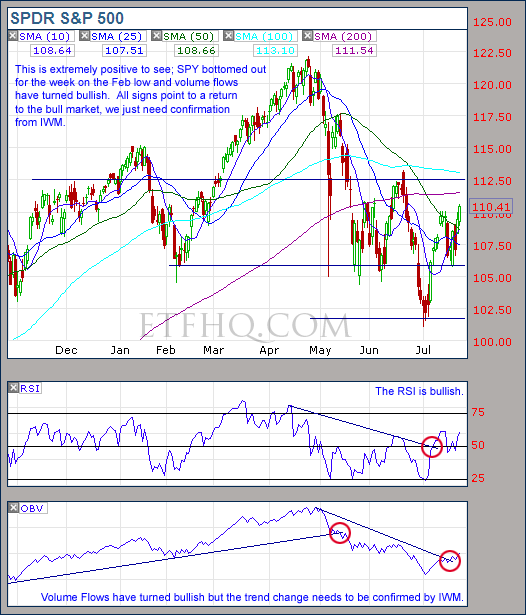
SPY says that the trend change has already occurred but we still need IWM to confirm.
.
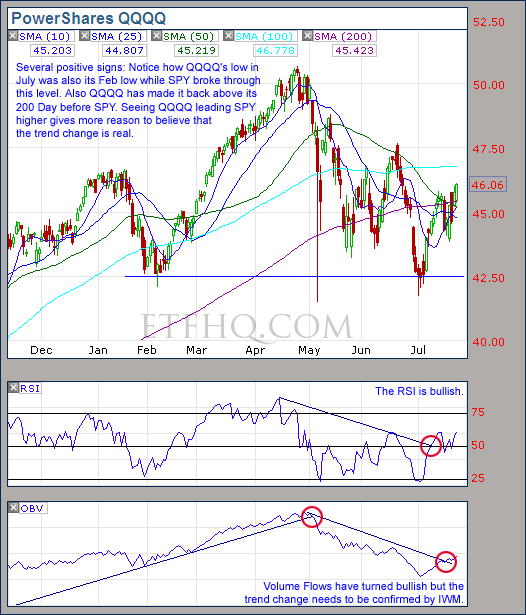
QQQQ is showing strength over SPY which is very positive. Now we just need IWM to confirm the trend change.
.
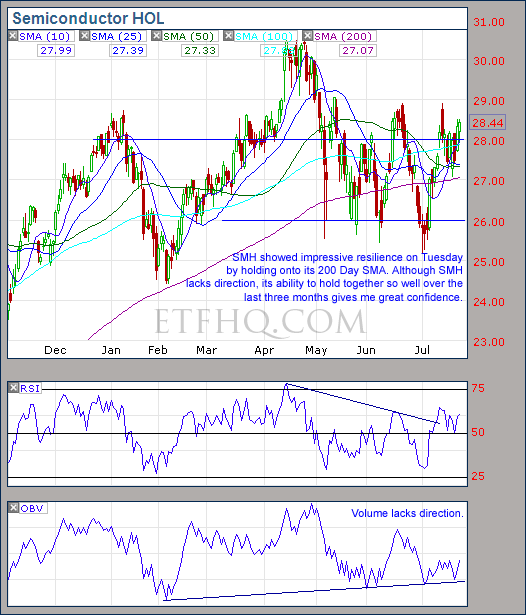
SMH lacks direction but continues to show strength which gives weight to the probability of a bullish trend change.
.
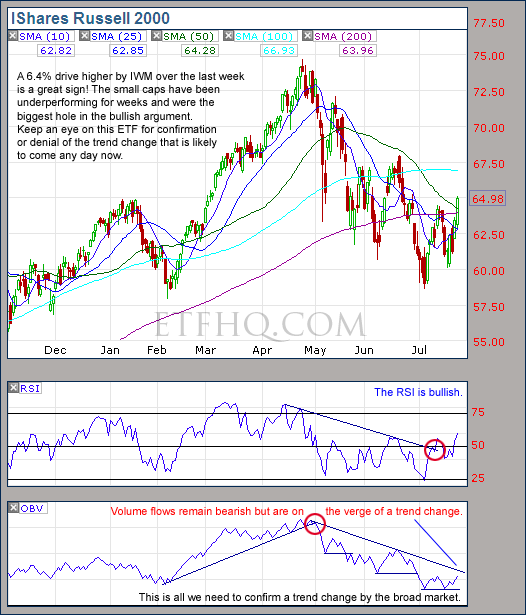
Waiting, waiting for confirmation from IWM. Keep an eye on that volume trend.
.
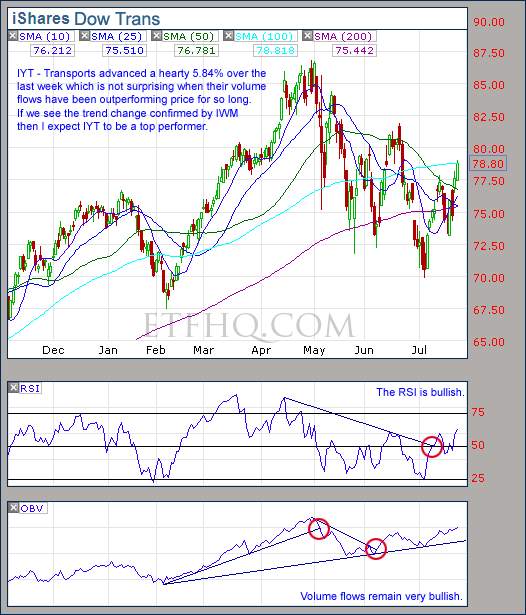
If we return to the bull market then transportation stocks are likely to do particularly well.
.
![]()
.
OM3 Weekly Indicator
.

The first buy signals (all be it ‘Weak Buy’ signals) in 10 weeks are a positive sign while the ‘Bull Alerts’ indicate that the weekly cycle moved up for the third week in a row.
.
How to read the OM3 indicator
The OM3 indicator as with most of our models primarily reads price action and volume. The strong/weak buy/sell signals are self-explanatory. ‘No Signal’ means that the component readings are in conflict and cancel each other out.
The alerts let you know if the cycle is speeding up or slowing down, so when you get at ‘Strong Buy, Bear Alert’ for instance it simply means that the criteria for a strong buy is in place but this weeks cycle reading is weaker (or more bearish) than last weeks reading (the same is true in reverse).
The number of weeks that a signal has been repeated is displayed. Historically a ‘Strong Buy’ signal has lasted for an average of 6 weeks and a maximum of 42 weeks, while a ‘Strong Sell’ has lasted for an average of 4 weeks and a maximum of 16.
This is an indicator not a mechanical trading model. It is useful to assist in analyzing the market but for the best results should be combined with commonsense and support/resistance levels etc.
.
![]()
.
TransDow & NasDow
.

There remains no signal on the NasDow while on a positive note the TransDow opened a new position in the Transportation Index on Friday.
.
What the TransDow Readings tell us:
The TransDow measures dominance between the DJ Transportation Index (DJTI) and the Dow Jones Industrial Average (DJIA). In a strong market the more economically sensitive Transportation Index should be dominant over the DJIA.
Historically the DJTI has been dominant over the Dow 45% of the time. The annualized rate of return from the DJTI during this period was 18.47% with the biggest loss for one trade sitting at -13.27%. The annualized return from the DJIA during the periods it was dominant over the DJTI was just 4.06% and the biggest loss for one trade was -16.13%. A 4% stop-loss is applied to all trades adjusting positions only at the end of the week.
What the NasDow Readings tell us:
The NasDow measures dominance between the NASDAQ and the DJIA. Using the same theory behind the Trans Dow; in a strong market the more economically sensitive NASDAQ should be dominant over the DJIA.
Historically the NASDAQ has been dominant over the DJIA 44% of the time. Taking only the trades when the NASDAQ is above its 40 week moving average the annualized rate of return was 25.47% with the biggest loss for one trade sitting at –8.59%. The annualized rate on the DJIA during the periods it was dominant over the NASDAQ is just 8.88% and the biggest loss for one trade was –12.28%. A 8% stop-loss is applied to all trades adjusting positions only at the end of the week.
.
![]()
.
LTMF 80 & Liquid Q
.

Both LTMF 80 and Liquid Q remain in cash.
.
Historical Stats:
.

.
How The LTMF 80 Works
LTMF stands for Long Term Market Forecaster. It reads volume flows relative to price action and looks for out performance of volume measured on a percentage basis over the prior 12 months. During a sustained rally the readings will reach high levels (near 100%) making it imposable for the volume reading to always outperform price so any reading above 80% will maintain the buy signal. This system has outperformed the market over the last 10 years but performance has been damaged by some nasty losses. It only produces buy signals and only for QQQQ.
How Liquid Q Works
Liquid Q completely ignores price action and instead measures the relative flow of money between a selection of economically sensitive and comparatively stable ares of the market. It looks for times when the smart money is confident and and can be seen by through volume investing heavily is more risky areas due to an expectation of expansion. This system has outperformed the market over the last 10 years and remained in cash through most of the major declines. It only produces buy signals and only for QQQQ. We will provide more performance details on the web site for these systems soon.
.
![]()
.
Summary
Every sign but one now points to a bullish trend change and there is little negative that can be said about the market from a technical stand point. All we are waiting for now is confirmation in the way of a trend change from OBV on IWM. If it comes then there really is no excuse for holding short positions and the market should be full of medium term bullish opportunities.
If the 200 Day SMAs start falling and SMH closes below $27 then prospects of a trend change are probably dead and burred for the time being.
.
Any disputes, questions, queries, comments or theories are most welcome in the comments section below.
.
Derry
And the Team @ ETF HQ
“Equipping you to win on Wall St so that you can reach your financial goals.”
.
P.S Like ETFHQ on Facebook – HERE
.
![]()
.
Quote of the Day:
“A true master is not the one with the most students, but the one who creates the most Masters. A true leader is not the one with the most followers, but the one who creates the most leaders.”
– Neale Donald Walsch in Conversations With God
I have a question regarding the OM3 Indicator table. Does Weeks refer to the Signal or the Alert or the combination of the two? It appears to reference the Alert; however, your explanation suggests it refers to the Signal. Example: Last week, DIA had a “Strong Sell” Signal and “Bull Alert” Alert & Weeks equal 2. This week, DIA has a “Weak Buy” Signal and “Bull Alert” and “Bull Alert” & Weeks equal 3. If Weeks references the Signal, I would expect Weeks to be either 0 or 1 this week. And, if Weeks refers to a combination of Signal and Alert, I would expect either 0 or 1 week.
Another good question E H Harris, I should make this more clear, thanks for pointing out the confusion.
Markets trend and cycle and the OM3 indicator measures both aspects with the 'Alerts' specifically measuring the market cycle. The count for each 'Signal' and 'Alert' is separate. So for instance DIA has just turned to a fresh 'Weak Buy' signal but the cycle has gained strength for the third week in a row.
Does that explain things a little more clearly?
Cheers
Derry
In fact what you have is perfectly clear. For some reason, I only saw the last “Week” column. My question was pretty stupid!
Thanks
Not at all.